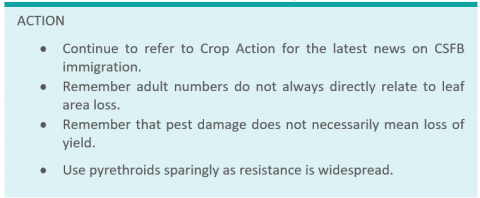Steve Ellis
Cabbage stem flea beetle (CSFB) damage is now becoming more obvious with shot-holing being reported from various areas across England. The recent very warm weather will have increased pest activity. There has been some re-drilling in where crops have been lost.
Due to high levels of CSFB resistance to pyrethroids across England, it is likely that these insecticides will provide little to no control of the adults where resistant populations are common. Treatment thresholds currently advise that a spray is only necessary if:
- 25% of leaf area is lost at the cotyledon-2 leaf stage, increasing to
- 50% of leaf area lost at the 3-4 leaf stage.
Routine sprays at the first sign of damage must be avoided. If an initial spray is not effective, resist the temptation to spray again as repeated sprays will increase the likelihood of higher levels of resistance developing. Natural enemies of CSFB such as ground beetles and parasitic wasps are also known to be susceptible to pyrethroids, so spraying resistant CSFB populations is likely to do more harm than good.
The physiologists suggest that 10 plants/m2 is often enough to produce a reasonable yield so crops with this number of plants should not be written off too early. The decision will depend on the patchiness of establishment, plant vigour and the likelihood of a spring drought. Additionally, it is important to be mindful of the level of CSFB larval infestation that is likely. Crops drilled early are likely to have higher larval pressures than those drilled late but may be better at tolerating this pressure because they will have larger, more forward plants. In contrast, crops that were sown later and are less vigorous, may be less tolerant of larval damage in the spring.

Slugs are causing problems in emerging oilseed rape with weather conditions being ideal for their activity. Some crops in the south of England have already received two applications of pellets. In small crops slugs can reduce plant numbers and as crops grow the level of leaf grazing also becomes important. Once beyond the four true leaf stage crops are no longer likely to be susceptible to slugs.
There is no threshold for the area of leaf loss from slug grazing that would justify application of molluscicide pellets. However, it would seem sensible to adopt the same guidelines that are used for leaf grazing by cabbage stem flea beetle. These suggest that treatment is justified if:
- 25% of leaf area is lost at the 1-2 leaf stage, increasing to
- 50% of leaf area is lost at the 3-4 leaf stage.

